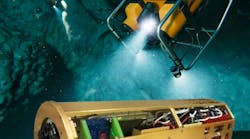Officials of the Naval Research Laboratory in Washington are asking L-3 Cincinnati Electronics to perform research work related to the Combined EO/IR Surveillance and Response System (CESARS) program.
Company experts will design and test mid-wave infrared (MWIR) and visible spectrum panoramic imagers on the Shipboard Panoramic Electro-optic Infrared (EO/IR) Cueing and Surveillance System (SPECSS) function of the of the CESARS system.
CESARS is a research project to develop electro-optical shipboard defense system to protect surface warships from anti-ship missiles, fast attack craft, fast inshore attack craft, and unmanned aerial vehicles (UAVs).
Related: Navy approaches industry for electro-optical dome of imaging over surface warships
CESARS combines two research initiatives -- SPECSS and the Multispectral EO/IR Countermeasures for Advanced Threats (MEIRCAT) project. Together these two technology capabilities should provide comprehensive shipboard defense against optically guided anti-ship missiles, attack boats, and attack drones.
SPECSS includes an enhanced electro-optical and infrared (EO/IR) countermeasure and situational awareness capability. It perform wide field-of-view target detection and tracking, and cues MEIRCAT high-resolution sensors.
MEIRCAT, meanwhile, performs target re-acquisition, tracking, classification, identification, 3-D ranging, threat assessment, countermeasures execution, and countermeasures effectiveness monitoring (CMEM). It will offer multi-band capability against many different targets in one engagement.
The combined CESARS program will use modular, open-systems hardware and software architectures that are scalable to different platforms. Its interface specifications, data formats, and source code, will be non-proprietary and government owned.
The overall CESARS system also will provide video data acquisition, dissemination, recording, processing, and display; high-resolution classification, identification, and tracking in several optical wavebands; integrated, precise, and real-time, active and passive fine tracking and ranging in several wavebands; enhanced countermeasures capability; and provide precise 3-D ranging and countermeasures monitoring to the shipboard combat system.
The CESARS contractors are developing the SPECSS and MEIRCAT systems independently. Navy experts, meanwhile, will handle combining the two for shipboard integration.
On this contract L-3 Cincinnati Electronics will do the work in Mason, Ohio, and should be finished by November 2018. For more information contact L-3 Cincinnati Electronics online at www.l-3com.com/ce, or the Naval Research Laboratory at www.nrl.navy.mil.



